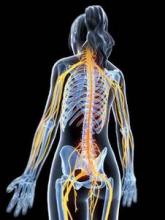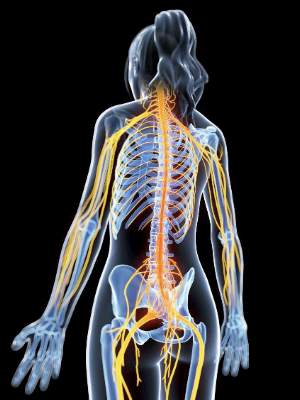User login
Specific polymorphisms of the SCN10A gene affect motor coordination and functional status in relapsing-onset multiple sclerosis (MS) patients via the abnormal expression of the voltage-gated Nav1.8 sodium channel in cerebellar Purkinje neurons, causing dysfunctional cerebellothalamic circuitry, according to findings from a prospective cohort study.
The clinical effects of abnormally expressed Nav1.8 in cerebellar Purkinje neurons and the polymorphisms’ effect on the activity of the channels in affected patients suggests that “SCN10A genotype may predict an MS subphenotype with significantly greater deficit in motor coordination and cognition and compromised cerebellothalamic functional integrity. This study further supports previous evidence that Nav1.8 channelopathy is involved in the pathophysiology of cerebellar dysfunction in MS,” Dr. Tina Roostaei of the Tehran (Iran) University of Medical Sciences and her colleagues reported (Neurology. 2016 Jan 6. doi: 10.1212/WNL.0000000000002326). The authors noted that “unlike other clinical abnormalities in MS that tend to be remitting, cerebellar dysfunction tends to become persistent early in the course of the illness and is refractory to either disease-modifying or symptomatic therapy.”
Genotyping for four potentially functional SCN10A polymorphisms in 161 patients with relapsing-onset MS and 94 healthy controls revealed two polymorphisms that proved significantly related to performance on the Multiple Sclerosis Functional Composite and all its subscores, with carriers of one polymorphism (rs6795970AA) performing worse than carriers of rs6795970G, regardless of Expanded Disability Status Scale score or cerebellar atrophy. However, carriers of rs6795970AA did not have significant gross ataxia as indexed by the Scale for the Assessment and Rating of Ataxia and cerebellar functional system score. The poor-performing carriers showed significantly diminished cerebellar functional connectivity with the thalami and midbrain on functional MRI. Similar results occurred for analyses of a separate polymorphism (rs6801957) that was in high-linkage disequilibrium with rs6795970. The effects of the polymorphisms were not seen in the healthy controls.
The effects of abnormal Nav1.8 channel expression on Purkinje cells is thought to alter their activity because Nav1.8 channels are normally found on unmyelinated sensory neurons of the dorsal root ganglia and peripheral nerve axons and support their repetitive firing by rapidly recovering from inactivation at depolarized membrane potentials.
The study by Dr. Roostaei and her colleagues and previous research suggests that it may be possible to reverse cerebellar manifestations of MS by blocking Nav1.8 with drugs currently in development for treating pain caused by pain-signaling cells in dorsal root ganglion neurons, which have been shown to improve clinical function in animal models of MS, wrote Dr. Stephen G. Waxman of Yale University, New Haven, Conn., and Dr. Orhun H. Kantarci of the Mayo Clinic, Rochester, Minn., in an accompanying editorial (Neurology. 2016 Jan 6. doi: 10.1212/WNL.0000000000002338). Additional work needs to be done with higher-resolution tests of cerebellar function to determine the effects of the abnormal presence of Nav1.8 on Purkinje cells in the cerebellum of MS patients, as well as further experiments to “understand the triggers that lead to upregulation of Nav1.8 expression in the cerebellum in MS.”
The study was supported by the Tehran University of Medical Sciences and the MS Society of Iran. One author reported receiving financial compensation from Biogen, Merck Serono, Bayer-Schering, Novartis, and CinnaGen for consulting and speaking services. Dr. Waxman reported holding a patent for invention of sodium channel Nav1.9, serving on the advisory board of SiteOne Therapeutics, and consulting for a variety of pharmaceutical companies. Dr. Kantarci reported receiving funding for travel and/or speaker honoraria from Novartis; research support from the European Regional Development Fund, National Multiple Sclerosis Society, Mayo Foundation, and Hilton Foundation; and participating in grant review for the National Multiple Sclerosis Society.
Specific polymorphisms of the SCN10A gene affect motor coordination and functional status in relapsing-onset multiple sclerosis (MS) patients via the abnormal expression of the voltage-gated Nav1.8 sodium channel in cerebellar Purkinje neurons, causing dysfunctional cerebellothalamic circuitry, according to findings from a prospective cohort study.
The clinical effects of abnormally expressed Nav1.8 in cerebellar Purkinje neurons and the polymorphisms’ effect on the activity of the channels in affected patients suggests that “SCN10A genotype may predict an MS subphenotype with significantly greater deficit in motor coordination and cognition and compromised cerebellothalamic functional integrity. This study further supports previous evidence that Nav1.8 channelopathy is involved in the pathophysiology of cerebellar dysfunction in MS,” Dr. Tina Roostaei of the Tehran (Iran) University of Medical Sciences and her colleagues reported (Neurology. 2016 Jan 6. doi: 10.1212/WNL.0000000000002326). The authors noted that “unlike other clinical abnormalities in MS that tend to be remitting, cerebellar dysfunction tends to become persistent early in the course of the illness and is refractory to either disease-modifying or symptomatic therapy.”
Genotyping for four potentially functional SCN10A polymorphisms in 161 patients with relapsing-onset MS and 94 healthy controls revealed two polymorphisms that proved significantly related to performance on the Multiple Sclerosis Functional Composite and all its subscores, with carriers of one polymorphism (rs6795970AA) performing worse than carriers of rs6795970G, regardless of Expanded Disability Status Scale score or cerebellar atrophy. However, carriers of rs6795970AA did not have significant gross ataxia as indexed by the Scale for the Assessment and Rating of Ataxia and cerebellar functional system score. The poor-performing carriers showed significantly diminished cerebellar functional connectivity with the thalami and midbrain on functional MRI. Similar results occurred for analyses of a separate polymorphism (rs6801957) that was in high-linkage disequilibrium with rs6795970. The effects of the polymorphisms were not seen in the healthy controls.
The effects of abnormal Nav1.8 channel expression on Purkinje cells is thought to alter their activity because Nav1.8 channels are normally found on unmyelinated sensory neurons of the dorsal root ganglia and peripheral nerve axons and support their repetitive firing by rapidly recovering from inactivation at depolarized membrane potentials.
The study by Dr. Roostaei and her colleagues and previous research suggests that it may be possible to reverse cerebellar manifestations of MS by blocking Nav1.8 with drugs currently in development for treating pain caused by pain-signaling cells in dorsal root ganglion neurons, which have been shown to improve clinical function in animal models of MS, wrote Dr. Stephen G. Waxman of Yale University, New Haven, Conn., and Dr. Orhun H. Kantarci of the Mayo Clinic, Rochester, Minn., in an accompanying editorial (Neurology. 2016 Jan 6. doi: 10.1212/WNL.0000000000002338). Additional work needs to be done with higher-resolution tests of cerebellar function to determine the effects of the abnormal presence of Nav1.8 on Purkinje cells in the cerebellum of MS patients, as well as further experiments to “understand the triggers that lead to upregulation of Nav1.8 expression in the cerebellum in MS.”
The study was supported by the Tehran University of Medical Sciences and the MS Society of Iran. One author reported receiving financial compensation from Biogen, Merck Serono, Bayer-Schering, Novartis, and CinnaGen for consulting and speaking services. Dr. Waxman reported holding a patent for invention of sodium channel Nav1.9, serving on the advisory board of SiteOne Therapeutics, and consulting for a variety of pharmaceutical companies. Dr. Kantarci reported receiving funding for travel and/or speaker honoraria from Novartis; research support from the European Regional Development Fund, National Multiple Sclerosis Society, Mayo Foundation, and Hilton Foundation; and participating in grant review for the National Multiple Sclerosis Society.
Specific polymorphisms of the SCN10A gene affect motor coordination and functional status in relapsing-onset multiple sclerosis (MS) patients via the abnormal expression of the voltage-gated Nav1.8 sodium channel in cerebellar Purkinje neurons, causing dysfunctional cerebellothalamic circuitry, according to findings from a prospective cohort study.
The clinical effects of abnormally expressed Nav1.8 in cerebellar Purkinje neurons and the polymorphisms’ effect on the activity of the channels in affected patients suggests that “SCN10A genotype may predict an MS subphenotype with significantly greater deficit in motor coordination and cognition and compromised cerebellothalamic functional integrity. This study further supports previous evidence that Nav1.8 channelopathy is involved in the pathophysiology of cerebellar dysfunction in MS,” Dr. Tina Roostaei of the Tehran (Iran) University of Medical Sciences and her colleagues reported (Neurology. 2016 Jan 6. doi: 10.1212/WNL.0000000000002326). The authors noted that “unlike other clinical abnormalities in MS that tend to be remitting, cerebellar dysfunction tends to become persistent early in the course of the illness and is refractory to either disease-modifying or symptomatic therapy.”
Genotyping for four potentially functional SCN10A polymorphisms in 161 patients with relapsing-onset MS and 94 healthy controls revealed two polymorphisms that proved significantly related to performance on the Multiple Sclerosis Functional Composite and all its subscores, with carriers of one polymorphism (rs6795970AA) performing worse than carriers of rs6795970G, regardless of Expanded Disability Status Scale score or cerebellar atrophy. However, carriers of rs6795970AA did not have significant gross ataxia as indexed by the Scale for the Assessment and Rating of Ataxia and cerebellar functional system score. The poor-performing carriers showed significantly diminished cerebellar functional connectivity with the thalami and midbrain on functional MRI. Similar results occurred for analyses of a separate polymorphism (rs6801957) that was in high-linkage disequilibrium with rs6795970. The effects of the polymorphisms were not seen in the healthy controls.
The effects of abnormal Nav1.8 channel expression on Purkinje cells is thought to alter their activity because Nav1.8 channels are normally found on unmyelinated sensory neurons of the dorsal root ganglia and peripheral nerve axons and support their repetitive firing by rapidly recovering from inactivation at depolarized membrane potentials.
The study by Dr. Roostaei and her colleagues and previous research suggests that it may be possible to reverse cerebellar manifestations of MS by blocking Nav1.8 with drugs currently in development for treating pain caused by pain-signaling cells in dorsal root ganglion neurons, which have been shown to improve clinical function in animal models of MS, wrote Dr. Stephen G. Waxman of Yale University, New Haven, Conn., and Dr. Orhun H. Kantarci of the Mayo Clinic, Rochester, Minn., in an accompanying editorial (Neurology. 2016 Jan 6. doi: 10.1212/WNL.0000000000002338). Additional work needs to be done with higher-resolution tests of cerebellar function to determine the effects of the abnormal presence of Nav1.8 on Purkinje cells in the cerebellum of MS patients, as well as further experiments to “understand the triggers that lead to upregulation of Nav1.8 expression in the cerebellum in MS.”
The study was supported by the Tehran University of Medical Sciences and the MS Society of Iran. One author reported receiving financial compensation from Biogen, Merck Serono, Bayer-Schering, Novartis, and CinnaGen for consulting and speaking services. Dr. Waxman reported holding a patent for invention of sodium channel Nav1.9, serving on the advisory board of SiteOne Therapeutics, and consulting for a variety of pharmaceutical companies. Dr. Kantarci reported receiving funding for travel and/or speaker honoraria from Novartis; research support from the European Regional Development Fund, National Multiple Sclerosis Society, Mayo Foundation, and Hilton Foundation; and participating in grant review for the National Multiple Sclerosis Society.
FROM NEUROLOGY
Key clinical point: New evidence further supports previous evidence that Nav1.8 channelopathy is involved in the pathophysiology of cerebellar dysfunction in MS.
Major finding: Two polymorphisms in the SCN10A gene were associated with worse performance on the Multiple Sclerosis Functional Composite and all its subscores, regardless of Expanded Disability Status Scale score or cerebellar atrophy.
Data source: A prospective cohort study of 161 patients with relapsing-onset MS and 94 healthy controls.
Disclosures: The study was supported by the Tehran University of Medical Sciences and the MS Society of Iran. One author reported receiving financial compensation from Biogen, Merck Serono, Bayer-Schering, Novartis, and CinnaGen for consulting and speaking services. Dr. Waxman reported holding a patent for invention of sodium channel Nav1.9, serving on the advisory board of SiteOne Therapeutics, and consulting for a variety of pharmaceutical companies. Dr. Kantarci reported receiving funding for travel and/or speaker honoraria from Novartis; research support from the European Regional Development Fund, National Multiple Sclerosis Society, Mayo Foundation, and Hilton Foundation; and participating in grant review for the National Multiple Sclerosis Society.

